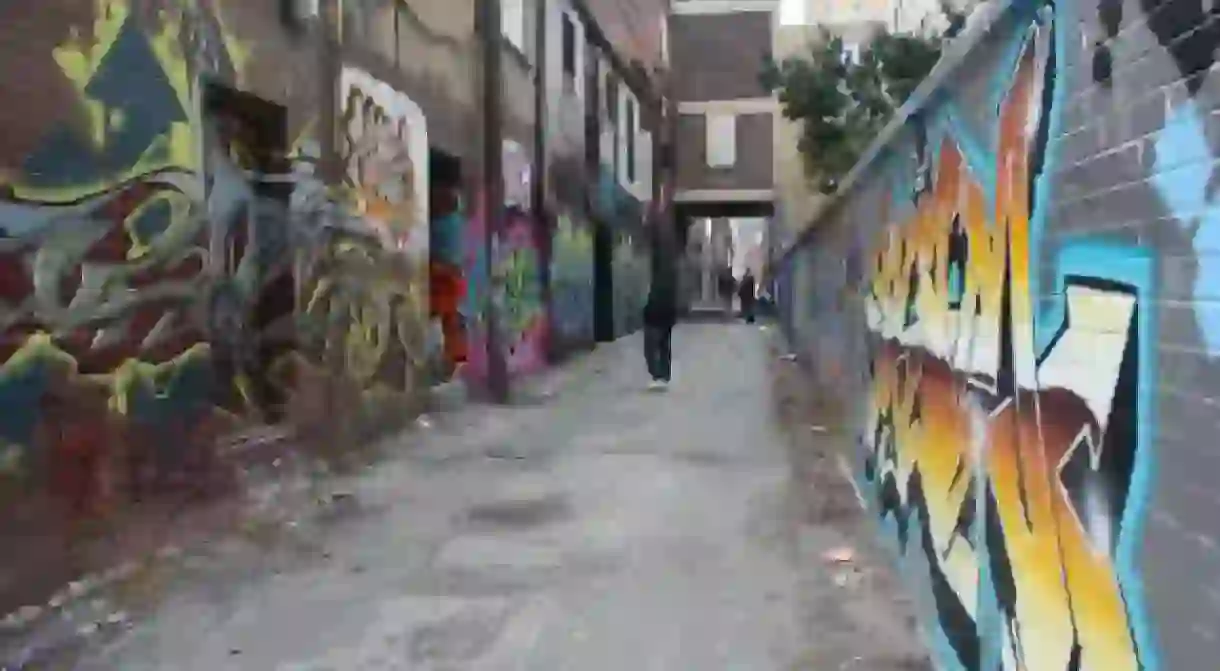Toronto’s Graffiti War: Art or Vandalism?

Toronto is renowned as the cultural capital of Canada. However, as Carla Bragagnini reports, one form of art has come under scrutiny in recent years. Toronto is an established centre of graffiti in North America, but the city’s governing forces are cracking down, putting the existence of street art hubs – such as Graffiti Alley – at risk.

Thousands flock to Toronto’s famed Queen Street West every year, hoping to soak in the wide spectrum of art galleries and get their fix of the diverse art, design and fashion of Canada’s urban capital. But those familiar with the city’s underground art scene will tell you that one of Toronto’s best art galleries is not found on Queen Street, but in an alley tucked away behind. Straying from the main street of galleries will unveil one of the city’s greatest hidden treasures: Rush Lane, better known as Graffiti Alley. This seemingly endless one kilometre long stretch of concrete canvas runs from Spadina Avenue to Portland Avenue, and is decorated by some of the world’s most celebrated street artists.

As striking as the colourful walls in Graffiti Alley, is the recent crackdown on the illegal act of graffiti throughout the city. Since coming into office in 2010, Toronto’s controversial mayor, Rob Ford, has gone to great lengths in a campaign to eradicate graffiti, including creating a Smartphone app that allows Torontonians to photograph and report graffiti in the city, leaving property owners to foot the clean-up bill. Adding to the criticism are Ford’s simultaneous funding cuts for community initiatives that commissioned youth to paint murals in many of Toronto’s unique neighbourhoods; an attempt to keep vandalism off the streets. Needless to say, Ford’s war on graffiti has made him a popular target of street art, with his image frequently reproduced on the city’s walls.

To better understand the debate, it’s important to note the difference between vandalism graffiti and skilled street art. To see that difference, one just needs to pay a visit to the Graffiti Alley. The city has since deemed the outdoor gallery of ‘municipal significance’ and exempted it from its strict anti-graffiti bylaw.
Since the nature of street art is inevitably volatile and constantly evolving or disappearing (even Banksy left his mark in Toronto a few years ago, but most of those works are gone), most street pieces have a short life-span. However, there is a great deal of respect for the art in Graffiti Alley. Even ‘taggers’ and ‘toys’ (unskilled scribblers, often writing mindless graffiti on available surfaces) leave most of the art in Graffiti Alley untouched. As such, the alley features intricate street art by famous graffiti artists, past and present, local and international. A stroll down the alley will reveal well-preserved works by some of Toronto’s finest: Elicser, Spud, Uber, Poser and DeadBoy.

Graffiti Alley is not the only spot in town displaying ancient graffiti relics. Shortly after Brick Works, a brick-making factory in Toronto, closed its doors in 1984, it became a haven for street youth. In the thirty years since Brick Works closed, the factory’s unoccupied kiln facilities have become covered in spray paint, some of which pays homage to the past, with portraits of former kiln workers. The art collective now features contributions from Robot, Nektar, Ochrehe, Artchild, Bacon and even New York’s Utah, who served time in prison for graffiti vandalism in 2009. The colourful shapes contrast beautifully with the worn-down industrial walls, rusty pipes and broken-down machinery, making it a popular stop for photographers in the city. Unfortunately, the art at Brick Works is currently under review to determine whether it is of ‘cultural significance’ to the city following a complaint the Mayor’s office received last year.

There is, however, another side to the fight against graffiti in Toronto, with some notable institutions taking a stand for local artists. Earlier this year, the Art Gallery of Ontario supported the cause, partnering with streets artists Pascal Paquette and Sean Martindale to bring street art indoors. This bold move demonstrated the AGO’s support of evolving concepts of art. Their ‘NOW: A Collaborative Project’ program included open forums and discussions on issues in Toronto and graffiti tours around the city, among other initiatives.
The city created a database called Street Art Showcase to expose protected street art in Toronto. Registering graffiti allows for the preservation of significant commissioned and non-commissioned art; although in some cases, it is used by savvy property owners hoping to skip the graffiti clean-up bill. The city also stood behind Toronto’s first festival celebrating different forms of street art.
Although progress has been made this past year, with a determined Mayor still in office, the graffiti debate in Toronto continues. One thing is for certain: understanding the difference between art and vandalism is key, not only in order to preserve the city’s significant cultural works, but also its cultural identity.
By Carla Bragagnini













